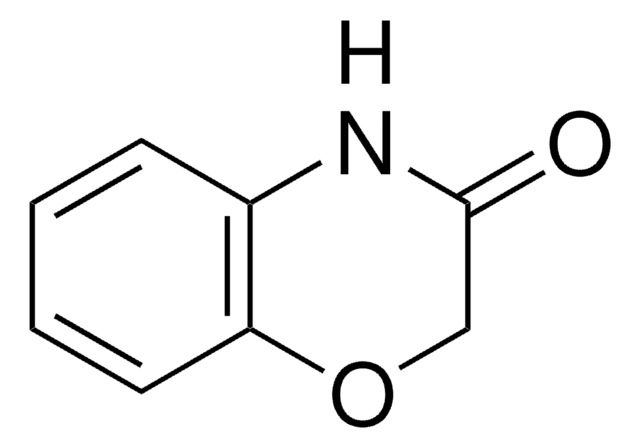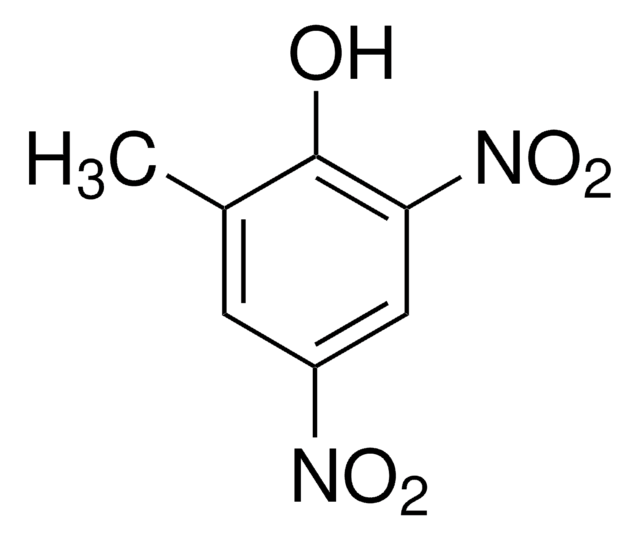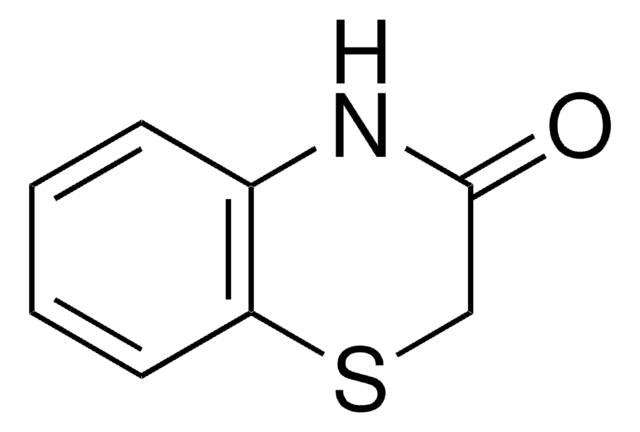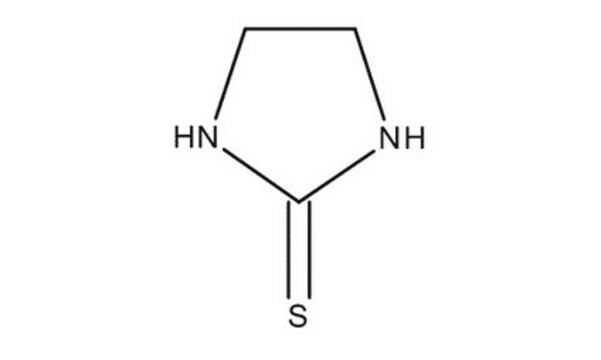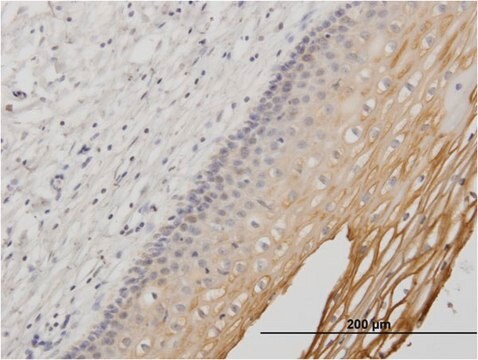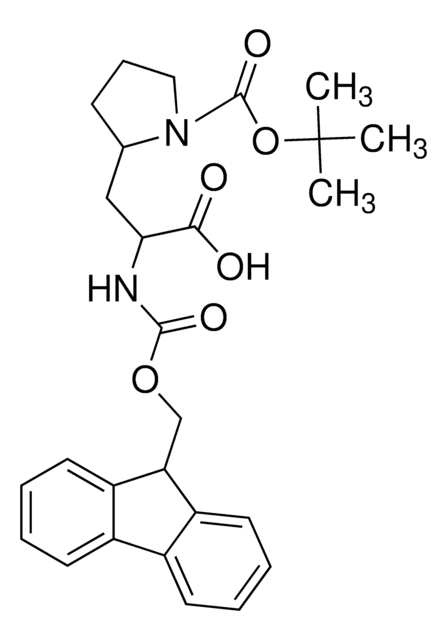Kluczowe dokumenty
CRM69083
Dinoseb
certified reference material, TraceCERT®, Manufactured by: Sigma-Aldrich Production GmbH, Switzerland
Synonim(y):
2-sec-Butyl-4,6-dinitrophenol
About This Item
Polecane produkty
klasa czystości
certified reference material
TraceCERT®
Poziom jakości
linia produktu
TraceCERT®
okres trwałości
limited shelf life, expiry date on the label
producent / nazwa handlowa
Manufactured by: Sigma-Aldrich Production GmbH, Switzerland
Format
neat
temp. przechowywania
2-8°C
ciąg SMILES
CCC(C)c1cc(cc(c1O)[N+]([O-])=O)[N+]([O-])=O
InChI
1S/C10H12N2O5/c1-3-6(2)8-4-7(11(14)15)5-9(10(8)13)12(16)17/h4-6,13H,3H2,1-2H3
Klucz InChI
OWZPCEFYPSAJFR-UHFFFAOYSA-N
Szukasz podobnych produktów? Odwiedź Przewodnik dotyczący porównywania produktów
Powiązane kategorie
Opis ogólny
Certified content by quantitative NMR incl. uncertainty and expiry date are given on the certificate.
Download your certificate at: http://www.sigma-aldrich.com
Dinoseb is a selective nitrophenolic herbicide used for protection against postemergence of grass and broad-leaf weeds in vegetables, fruits, nuts, and other field crops such as soybeans. In addition, it also finds its use as an insecticide for grapes, and as a seed drying agent. It acts by uncoupling oxidative phosphorylation in mitochondria and inhibiting ATP synthesis.
Under the Regulation (EC) No 1107/2009 and withdrawing the Council Directives 79/117/EEC and 91/414/EEC, dinoseb is not approved for its use as a plant protection product in the European Union (EU). It was also banned for use as a pesticide in the US in 1986 by the US EPA (Environmental Protection Agency). But a default maximum residue limit (MRL) in the range of 0.02 mg/kg to 0.1 mg/kg is set for the presence of dinoseb (measured as a sum of dinoseb, its salts, dinoseb-acetate, and binapacryl) in products of plant and animal origin.
Zastosowanie
The dinoseb CRM may also be used to:
- Simultaneously determine dinoseb and pendimethalin in surface water samples using optimized direct injection (DI) and solid phase extraction (SPE) coupled to ultra high-performance liquid chromatography-tandem mass spectrometry (UPLC-MS/MS)
- Evaluate anodic voltametric analysis of dinoseb in river water samples using a boron doped diamond electrode following cathode pre-treatment and in the presence of cationic surfactants
- Extract 15 phenols from refinery wastewater samples by dispersive liquid-liquid microextraction (DLLME) technique and identify them by liquid chromatography-photodiode array detector (LC-PDA)
- Detect chlorophenoxy acid methyl esters and other chlorinated herbicides in peppermint tea, plum, and orange peel extract soft ionization gas chromatography coupled to quadrupole time-of-flight mass spectrometry (GC-QTOFMS)
- Analyze 32 pesticide residues of four different chemical classes in tea brew and tea leaves samples by a sample treatment method based on metabolomics and liquid chromatography-mass spectrometry (LC-MS)
- Determine pendimethalin, dinoseb and sodium 5-nitroguaiacolate in vegetable samples by differential pulse voltammetry (DPV) and chemometrics
Polecane produkty
Informacje prawne
Hasło ostrzegawcze
Danger
Zwroty wskazujące rodzaj zagrożenia
Zwroty wskazujące środki ostrożności
Klasyfikacja zagrożeń
Acute Tox. 2 Oral - Acute Tox. 3 Dermal - Aquatic Acute 1 - Aquatic Chronic 1 - Eye Dam. 1 - Repr. 1B - Skin Irrit. 2 - Skin Sens. 1
Zagrożenia dodatkowe
Kod klasy składowania
6.1A - Combustible, acute toxic Cat. 1 and 2 / very toxic hazardous materials
Klasa zagrożenia wodnego (WGK)
WGK 3
Temperatura zapłonu (°F)
306.9 °F - closed cup
Temperatura zapłonu (°C)
152.7 °C - closed cup
Wykazy regulacyjne
Wykazy regulacyjne dotyczą głównie produktów chemicznych. Można w nich podawać ograniczoną liczbę informacji na temat produktów niechemicznych. Brak wpisu oznacza, że żaden ze składników nie znajduje się w wykazie. Użytkownik odpowiada za zagwarantowanie bezpiecznego i zgodnego z prawem stosowania produktu.
EU REACH SVHC Candidate List
EU REACH Annex XVII (Restriction List)
Wybierz jedną z najnowszych wersji:
Certyfikaty analizy (CoA)
It looks like we've run into a problem, but you can still download Certificates of Analysis from our Dokumenty section.
Proszę o kontakt, jeśli potrzebna jest pomoc Obsługa Klienta
Masz już ten produkt?
Dokumenty związane z niedawno zakupionymi produktami zostały zamieszczone w Bibliotece dokumentów.
Nasz zespół naukowców ma doświadczenie we wszystkich obszarach badań, w tym w naukach przyrodniczych, materiałoznawstwie, syntezie chemicznej, chromatografii, analityce i wielu innych dziedzinach.
Skontaktuj się z zespołem ds. pomocy technicznej